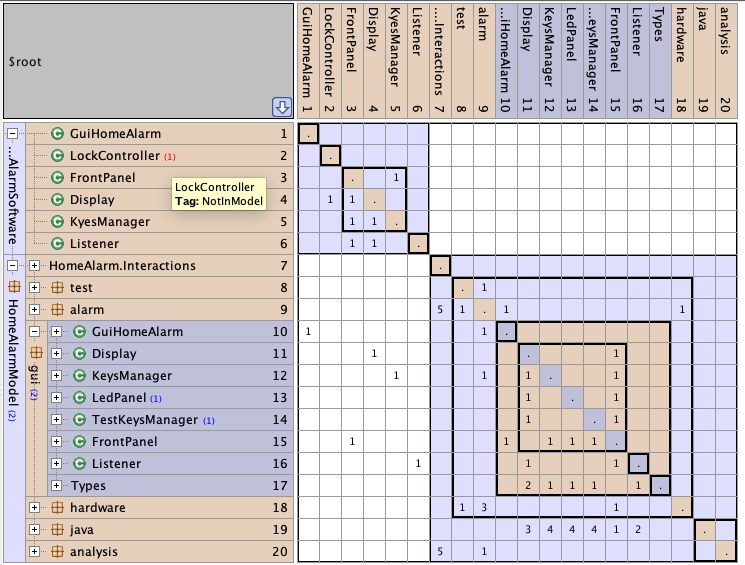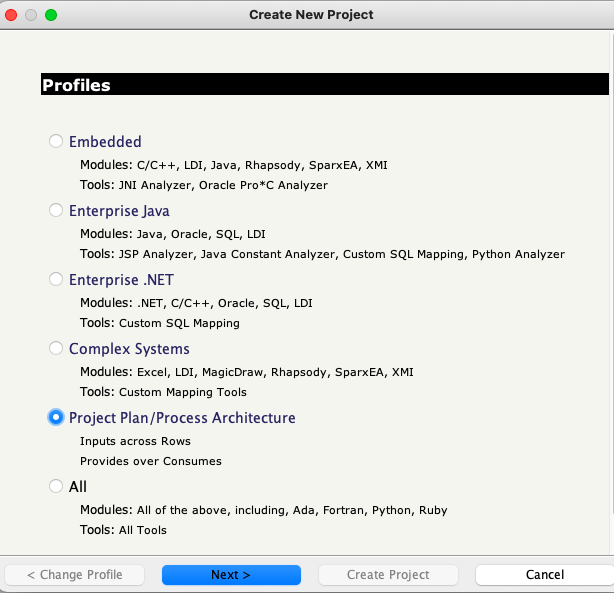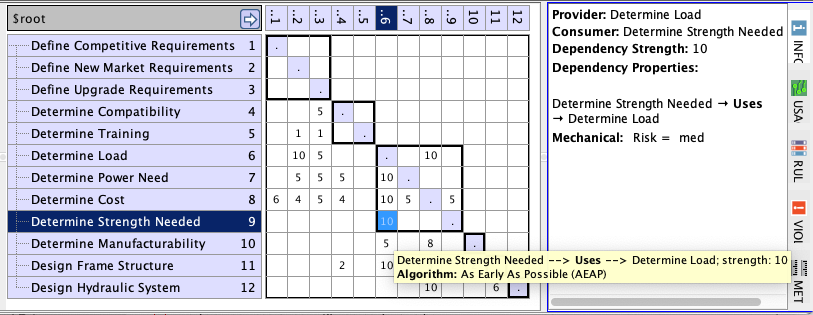Harnessing the Power of Your System Architecture
A SysML model of architecture is commonly considered the core of most complex product and systems development for MBSE, and yet the power of a well-defined architecture is often not fully exploited. Analysis of architecture using design structure matrices (DSM) in the early phases can help visualize all of the relationships in your model, identify undesirable cycles, and quantify inter-component coupling and ideal component cohesion.
Lattix can instantly analyze the XMI export from your SysML or UML modeling tool or directly loading the model from these vendors:
- Dassault Catia | Cameo or MagicDraw
- Sparx Enterprise Architect
- IBM Rhapsody
With Lattix, rules can be established in the model for compliance with the architecture to guide the system developers during development.
Our experts can train your team to quickly build and analyze your system
Compare As-Modeled to As-Implemented for Validation and Compliance
With the UML/SysML and software language analysis modules combined into one project, Lattix enables mapping of the code to the model and vice-versa to discover and control structural mismatches.
In this example, the tagged code and model elements are missing in the model or the implementation.
Master the Complexity of Your Systems and Operations with a Big Picture View
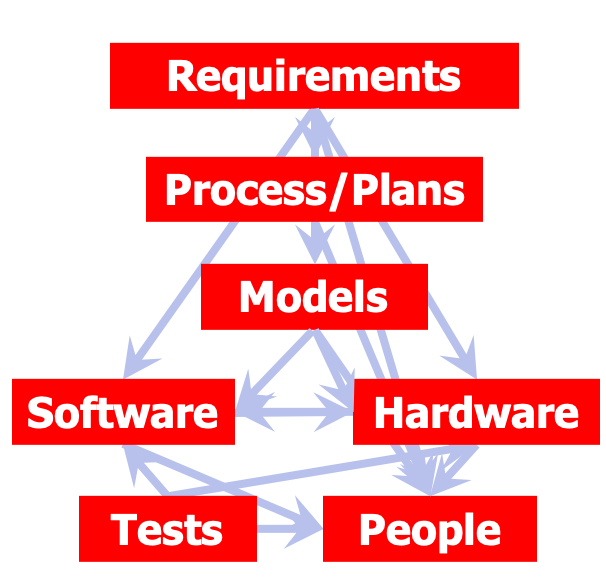
The power of the DSM representation is its scalability to traverse large complex systems, which include many domains with interdependencies. A multi-domain matrix (MDM) provides the cross domain mapping of relationships that enable the most comprehensive change impact analysis and discovery of issues across the system.
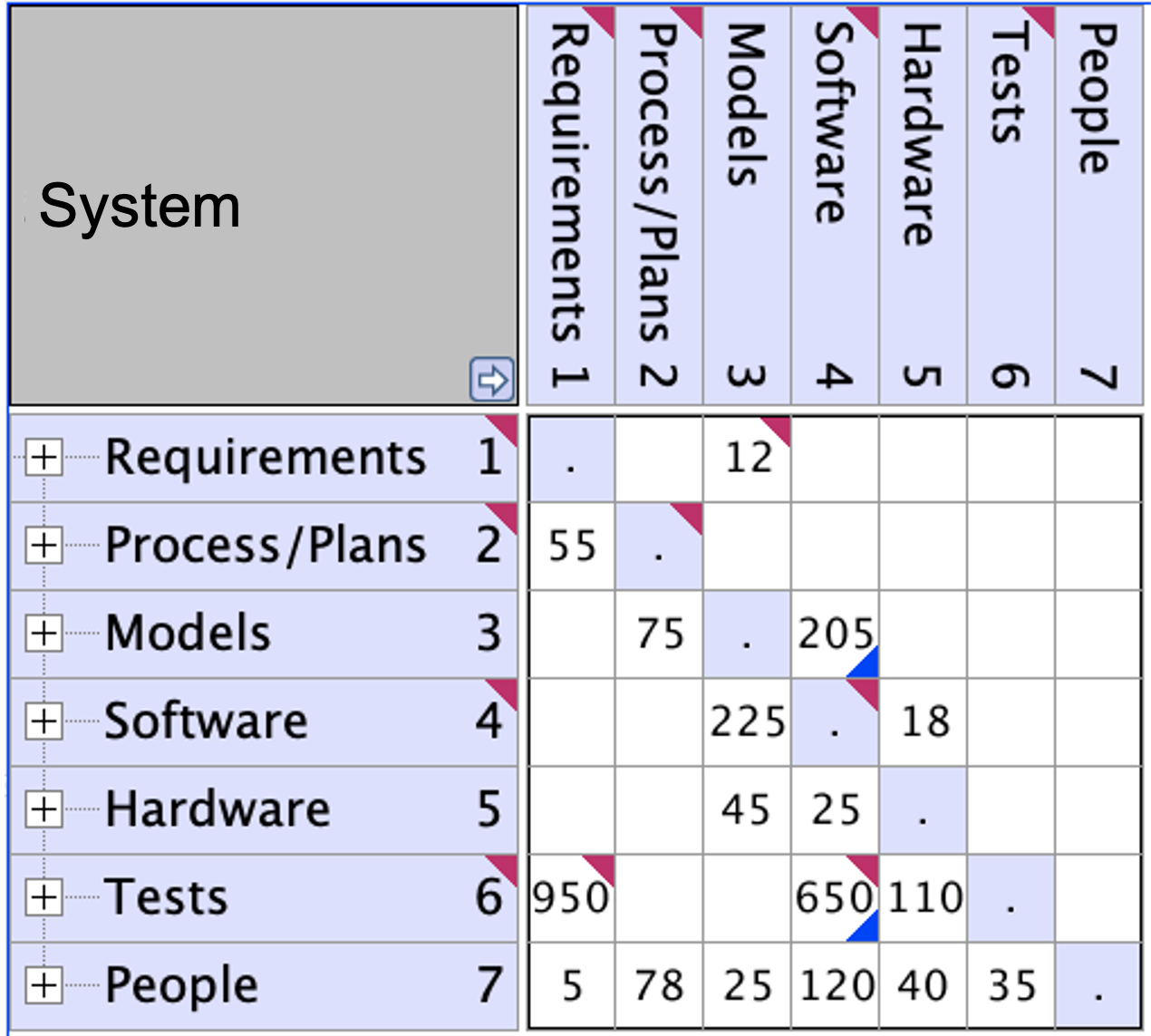
Optimize your Project Plans and Architect
Complex Processes
The challenge with conventional planning tools is the inability to deal with planned and unplanned iterations, which lead to delays and higher costs. DSM analysis enables optimal sequencing of activities which involve iterations, identifying opportunities to restructure processes to leverage planned cycles and minimize the impact unplanned rework.
Lattix now includes a special Profile for planning projects and architecting complex processes. The DSM is pre-configured for sequencing and partitioning with a number of algorithms.
Data in many formats can be imported to and exported from Lattix, including integrations with Excel and Microsoft Project.
Harnessing the Power of Your System Architecture
A SysML model of architecture is commonly considered the core of most digital engineering transformations, and yet the power of a well-defined architecture is often not fully exploited. Analysis of architecture using design structure matrices (DSM) in the early phases can help visualize all of the relationships in your model, identify undesirable cycles, and quantify inter-component coupling and ideal component cohesion.
Lattix can instantly analyze the XMI export from your SysML or UML modeling tool or directly loading the model from these vendors:
- Dassault Catia | Cameo or MagicDraw
- Sparx Enterprise Architect
- IBM Rhapsody
With Lattix, rules can be established in the model for compliance with the architecture to guide the system developers during development.
Our experts can train your team to quickly build and analyze your system
Compare As-Modeled to As-Implemented for Validation and Compliance
With the UML/SysML and software language analysis modules combined into one project, Lattix enables mapping of the code to the model and vice-versa to discover and control structural mismatches.
In this example, the tagged code and model elements are missing in the model or the implementation.
In Agile and DevOps environments, architectural analysis can be automated so that every time an architect checks in a new version of their model or a developer checks in new code, the results of the analysis are immediately available so that remediation can be made before becoming technical debt.
Master the Complexity of Your Systems and Operations with a Big Picture View

The power of the DSM representation is its scalability to traverse large complex systems, which include many domains with interdependencies. A multi-domain matrix (MDM) provides the cross domain mapping of relationships that enable the most comprehensive change impact analysis and discovery of issues across the system.

Optimize your Project Plans and Architect
Complex Processes
The challenge with conventional planning tools is the inability to deal with planned and unplanned iterations, which lead to delays and higher costs. DSM analysis enables optimal sequencing of activities which involve iterations, identifying opportunities to restructure processes to leverage planned cycles and minimize the impact unplanned rework.
Lattix now includes a special Profile for planning projects and architecting complex processes. The DSM is pre-configured for sequencing and partitioning with a number of algorithms.
Data in many formats can be imported to and exported from Lattix, including integrations with Excel and Microsoft Project.
Harnessing the Power of Your System Architecture
A SysML model of architecture is commonly considered the core of most digital engineering transformations, and yet the power of a well-defined architecture is often not fully exploited. Analysis of architecture using design structure matrices (DSM) in the early phases can help visualize all of the relationships in your model, identify undesirable cycles, and quantify inter-component coupling and ideal component cohesion.
Lattix can instantly analyze the XMI export from your SysML or UML modeling tool or directly loading the model from these vendors:
- Dassault Catia | Cameo or MagicDraw
- Sparx Enterprise Architect
- IBM Rhapsody
With Lattix, rules can be established in the model for compliance with the architecture to guide the system developers during development.
Our experts can train your team to quickly build and analyze your system
Compare As-Modeled to As-Implemented for Validation and Compliance
With the UML/SysML and software language analysis modules combined into one project, Lattix enables mapping of the code to the model and vice-versa to discover and control structural mismatches.
In this example, the tagged code and model elements are missing in the model or the implementation.
In Agile and DevOps environments, architectural analysis can be automated so that every time an architect checks in a new version of their model or a developer checks in new code, the results of the analysis are immediately available so that remediation can be made before becoming technical debt.
Master the Complexity of Your Systems and Operations with a Big Picture View

The power of the DSM representation is its scalability to traverse large complex systems, which include many domains with interdependencies. A multi-domain matrix (MDM) provides the cross domain mapping of relationships that enable the most comprehensive change impact analysis and discovery of issues across the system.

Optimize your Project Plans and Architect
Complex Processes
The challenge with conventional planning tools is the inability to deal with planned and unplanned iterations, which lead to delays and higher costs. DSM analysis enables optimal sequencing of activities which involve iterations, identifying opportunities to restructure processes to leverage planned cycles and minimize the impact unplanned rework.
Lattix now includes a special Profile for planning projects and architecting complex processes. The DSM is pre-configured for sequencing and partitioning with a number of algorithms.
Data in many formats can be imported to and exported from Lattix, including integrations with Excel and Microsoft Project.




